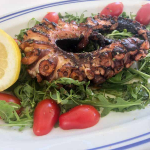At a Glance:
- Selecting a cheese supplier based on price can cost more in the long run due to quality issues and customer complaints.
- Unreliable delivery or poor supply chain handling disrupts kitchen operations.
- Even great cheese fails if it doesn’t suit your cooking methods or menu needs.
- A mismatch between supplier capacity and your needs creates major bottlenecks.
- Treating your supplier as a partner opens up opportunities for better support and insights.
Choosing the right cheese supplier might not seem like a big decision until it starts costing you customers.
Late deliveries, inconsistent quality, and poor menu fit can quickly lead to food waste, kitchen delays, and unsatisfied diners. When cheese plays a central role on your menu, supplier issues can ripple across your entire operation, impacting both revenue and reputation.
This article is for restaurant owners and operators who want reliable, high-quality cheese that meets their specific needs without the hassle. We’ll break down the most common mistakes restaurants make when choosing a cheese supplier so you can avoid them and make smarter, long-term decisions for your kitchen.
Prioritising Price Over Quality
Many restaurants make the mistake of selecting cheese suppliers based solely on price. However, sacrificing quality for savings can backfire. When customers notice the low-quality cheese in their meals, it affects their dining experience, which in turn can damage your business reputation. A lower cost per kilo might look good on paper, but it often comes at the expense of consistent cheese quality, flavour, and performance.
For instance, a pizzeria that switches to a cheaper cheese to cut costs may soon notice uneven melting, excessive oiling in the oven, or a bland flavour. Not only does this affect the appearance and mouthfeel of the pizza, but customer complaints and wasted products can quickly outweigh the initial savings.
Not Considering Menu Fit
One of the most overlooked factors when choosing a cheese supplier is ignoring the product alignment with your menu. For instance, does the cheese you’re sourcing complement the flavours in your key dishes? Will your cheese hold up under your specific cooking methods, like grilling, baking, steaming, or cold use? The menu fit goes beyond flavour and includes form (sliced, shredded, block), functionality (melt, stretch, hold), and consistency.
Even high-quality cheese can fall short if it doesn’t suit the flavour profile, application, or presentation needs of your dishes. For busy kitchens or multi-location operations, even small misalignments between product and application can cause service delays, waste, and inconsistent plating.
Selecting a supplier who understands your cuisine, cooking methods, and kitchen flow ensures your dishes consistently deliver on quality, efficiency, and customer satisfaction.
Overlooking Supply Chain Handling
Australia’s climate makes temperature control in dairy logistics critical. Yet, many buyers overlook a supplier’s cold chain capabilities, focusing solely on taste and pricing. If cheese is exposed to temperatures above 4°C for extended periods, it can spoil or develop undesirable textures, which is not only a risk of product waste but also a serious food safety hazard for customers.
Similarly, supply chain disruptions are a major risk. Unreliable delivery schedules, missed drop-offs, or inconsistent cold chain handling can disrupt kitchen operations, compromise food safety, and damage customer trust.
To ensure the cheese in your kitchen is of the highest quality and safe to use, make sure to source high-quality food service cheese from a reliable supplier. Check supplier reviews and references, their network of distributors and confirm their track record for on-time deliveries.
Missing the Benefits of a Strong Supplier Partnership
Many food service businesses treat cheese suppliers as mere vendors rather than strategic partners. This transactional mindset overlooks valuable opportunities.
A trusted supplier can provide usage guidance, suggest alternative cheese options, and even alert you to market price shifts ahead of time.
In Australia’s food service industry, where supply chains can be affected by transport delays, weather, or changes in international dairy demand, having a responsive and invested supplier relationship is a competitive advantage. Bulk cheese supply for restaurants can become much more efficient and profitable with a strong supplier partnership.
Mismatch in Supplier Capabilities with Restaurant Needs
In some cases, the cheese may be exactly what you need, but the supplier may not be. For instance, a supplier might offer outstanding cheese with exceptional flavour and texture yet struggle to meet the volume and delivery frequency required by a fast-growing, multi-site fast-food chain. Limited production capacity, minimal logistics infrastructure, or inefficient distribution network can quickly become operational bottlenecks.
On the other hand, large-scale suppliers that specialise in high-volume distribution may lack flexibility, customised formats, or responsive service required by smaller restaurants.
Therefore, understand your operational needs, such as volume, frequency, credit terms, and lead times. Then, choose a supplier who matches your capabilities.
You may as well ask these questions to assess the fit:
- Can the supplier consistently meet your volume requirements?
- Do they deliver to your locations on the required schedule?
- Can they supply cheese in the formats your kitchen needs (e.g. sliced, shredded, portioned)?
- Are they equipped to respond quickly to urgent restocks or seasonal surges?
By avoiding these common cheese supplier selection mistakes, you’ll set your restaurant up for a smoother, more efficient operation. Your restaurant will also have consistent, high-quality cheese that supports your menu and meets customer expectations.
Whether you’re looking for a parmesan cheese , mozzarella cheese, or any other cheese for your menu, make sure to choose a dairy supplier who can handle your specific needs to avoid costly disruptions and maintain customer satisfaction.











